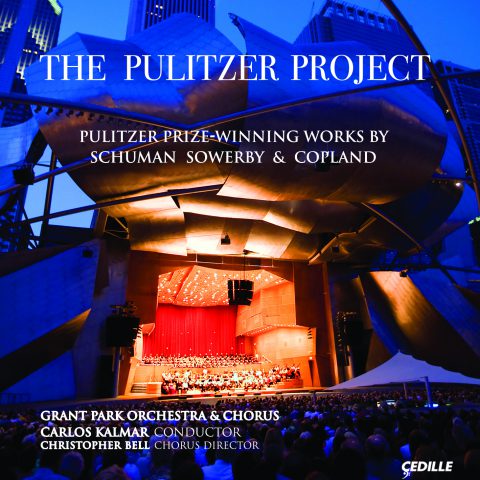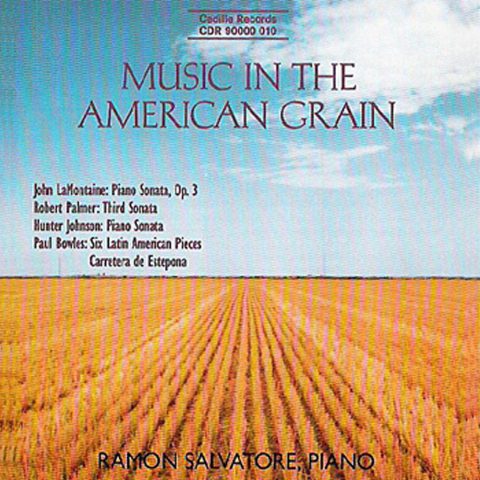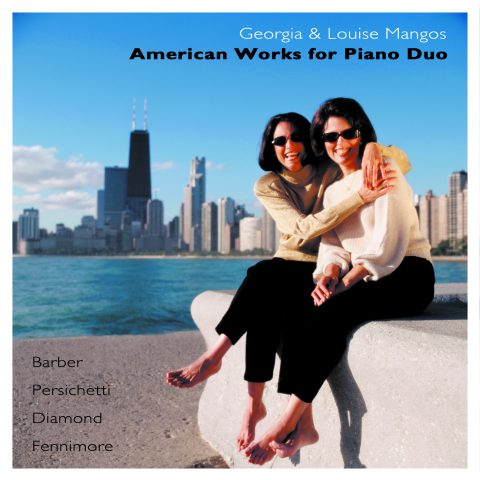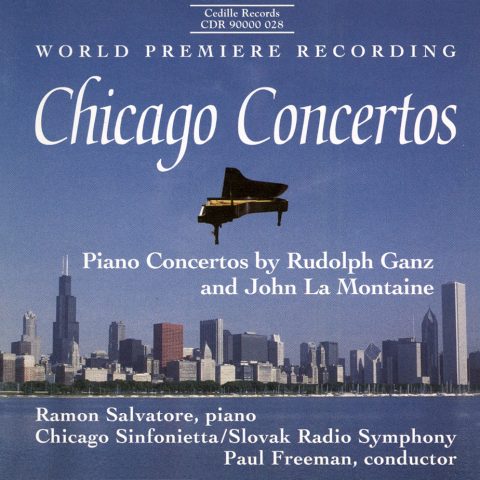Store
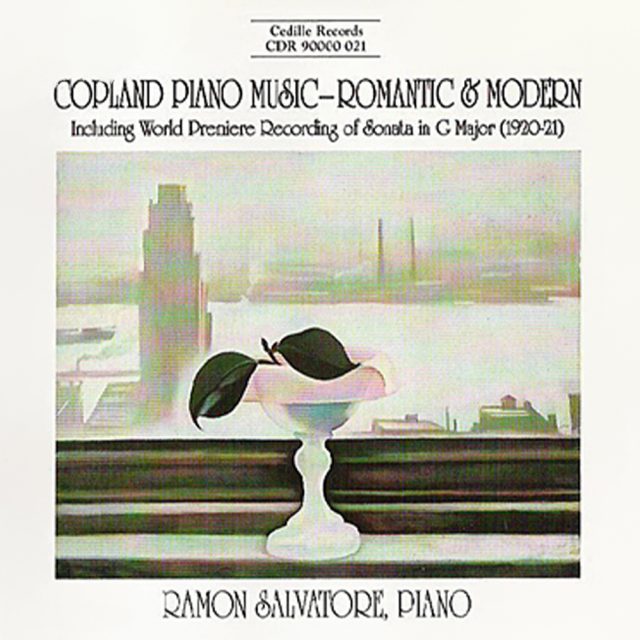
Store
Copland Piano Music — Romantic & Modern
While studying composition in New York, Aaron Copland composed a Romantic-style piano sonata in the grand manner. After nearly 75 years, his Sonata in G Major (1921) receives its performance and recording premieres by Chicago pianist Ramon Salvatore.
On this CD, Salvatore presents an unusually complete stylistic survey: the high Romanticism of the Sonata in G Major, Copland’s early flirtations with French impressionism and jazz, the classic Americana for which he’s best known, and his bold modernism. Unlike other Copland piano discs, Cedille’s includes only original piano works (no transcriptions), performed with clarity and imagination by a leading exponent of American piano music.
Composed at the behest of his traditionalist teacher Rubin Goldmark, Copland’s Sonata in G Major is his most ambitious early work. “It demonstrates a familiarity with and mastery of traditional form and harmony that is impressive,” writes composer Philip Ramey in his notes for the CD booklet. Ramey was a close friend and associate of Copland.
Pianist Salvatore says the German-Romantic style piece offers “all the elements that attract pianists and audiences to this kind of music” and could become a genuine audience-pleaser like Charles Ives’ similarly backward-looking First Symphony. “I invite the listener to decide,” Salvatore says.
Sonnet II (1919), a 27-bar miniature, is a sonorous, post-Impressionistic piece performed for the first time in 1985. The Cat and the Mouse (1920) caused a falling out between Copland and Goldmark over the “modernism” of its erratic rhythms and French impressionist veneer. The witty little piece became Copland’s first published work. Three Moods (1921) marks the first appearance of jazz in Copland’s work.
Serious, abstract, carefully articulated — yet emotionally stirring — Copland’s Passacaglia (1922) shows the influence of composition teacher Nada Boulanger, who stressed control and clarity.
Copland insisted that the sweetly pastoral miniature Down a Country Lane (1962), commissioned by Life magazine, had nothing to do with a country lane. “I didn’t think up the title until the piece was written,” he said. Ramey discovered Copland’s exquisite bagatelle Midsummer Nocturne (1947) while foraging through his friend’s files in 1977. It premiered in Cleveland in 1978.
The sternly challenging Proclamation (1973/82) and soothing Midday Thoughts (1944/82) are Copland’s last works in any genre. Both are based on sketches for never-completed works. Proclamation was originally intended as a large-scale piano piece. Midday Thoughts dates back to Copland’s Appalachian Spring period and shares the ballet’s sweet temperament.
The generous survey concludes with the fascinating Piano Fantasy (1957), Copland’s most complex and virtuosic work for solo piano. He wanted it to suggest “a spontaneous and unpremeditated sequence of ‘events’ that would carry the listener irresistibly (if possible) from first note to last.” Influence by 12-tone technique but fundamentally tonal, the work was commissioned by the Juilliard School of Music to celebrate its 50th anniversary.
Preview Excerpts
AARON COPLAND (1900-1990)
Sonata in G Major
Three Moods
Piano Fantasy
Artists
Program Notes
Download Album BookletAaron Copland Piano Music
Notes by Phillip Ramey
Sonata in G Major
Although the French pedagogue Nadia Boulanger was by far Aaron Copland’s most important and influential teacher, his early private studies (1917-21) in harmony, counterpoint and composition with Rubin Goldmark in New York were also crucial. Goldmark was the nephew of Karl Goldmark, composer of the then-popular opera The Queen of Sheba, and had studied with Antonin Dvorák. Copland remembered that Rubin Goldmark “had an excellent grasp of the fundamentals of music and knew very well how to impart his ideas.” As a result, the young man was spared “the flounderings that so many American musicians have suffered through incompetent teaching at the start of their training.”
The bulk of Copland’s juvenilia consists of brief piano pieces and songs. “During these formative years,” he wrote, “I had been gradually uncovering for myself the literature of music. Some instinct seems to lead me logically from Chopin’s waltzes to Haydn’s sonatinas to Beethoven’s sonatas to Wagner’s operas. And from there it was but a step to Hugo Wolf’s songs, to Debussy’s preludes, and to Scriabin’s piano poems… As far as I can remember no one ever told me about modern music.” Certainly, the arch-conservative Goldmark never did, except to denigrate it, and that, Copland recalled, “was enough to whet any young man’s appetite. The fact that [modern] music was in some sense forbidden only increased its attractiveness.”
As a kind of graduation exercise, Goldmark insisted that Copland compose a sonata. “In his mind the sonata form was the pinnacle of our work together… He considered especially the first- movement sonata-allegro form the key to all future composition, and would not allow me to leave town without it!” The result was Copland’s most ambitious early score, the Sonata in G Major for Piano, written from 1920 to June 1921. (A note on the manuscript reads: “Composed for Rubin Goldmark as final student work”; only a few days after he finished it, Copland left for France for further studies.)
Whatever interest attaches to this unpublished three-movement piece must be chiefly historical. The G Major Sonata is so derivative — of Beethoven, Brahms, Mendelssohn — that it gives no indication at all of any personal style. But it does demonstrate a familiarity with and mastery of traditional form and harmony that is impressive.
I remember that once, when examining the manuscript with Copland as he played through parts of it, he termed the music “completely conventional — something I had to come up with to make Rubin Goldmark happy. It was written in absolute conformity to the ‘rules’.” He told me it had never been performed publicly, and when I asked if he would allow such a performance, he said no. Still, it was clear to me that he was uninterested in rather than ashamed of his early exercise. A few years after his death, Copland’s executors decided to make the work available. Ramon Salvatore gave the world premiere of the Sonata in G Major on May 21, 1995, at the National Gallery in Washington, D.C.
Mr. Salvatore has written about the work as follows:
When I first had the opportunity to examine the manuscript of the Sonata in G Major at the Library of Congress, I was struck by the care Copland evidently gave the work. It appeared to be a thoroughly well-made piece, with much attention given to detail. The Sonata is in a consistent German-romantic style and contains all the trappings of that genre: rich harmonies, thick sonorities, long singing lines, arpeggiated basses, big climaxes — in short, all the elements that attract pianists, and audiences to this kind of music.
The Sonata is logically developed, concise, and straightforward. The first movement (Allegro maestoso), in G major, is in traditional sonata form, with each theme and idea clearly audible. The second movement (Andante cantabile), in D-flat major and A-B-A form, achieves an expansive climax in the coda. The last movement (Allegro Vivace), in G minor, is in rondo form with the first and second themes effectively combined in the development. It ends with a truly virtuosic drive.
While it is of undoubted historical interest, I believe this extravagantly romantic Sonata has sufficient intrinsic merit to become a genuine audience-pleaser like Charles Ives’ similarly backward-looking First Symphony (which Ives wrote as a student of conservative composer Horatio Parker). I invite the listener to decide.
Sonnet II
The score of the unpublished Sonnet II is dated April 10, 1919. At the head of the music is the dedication, “to A.V.” (Arne Vainio, Copland told me, was a young, intelligent, handsome Finnish cellist-friend with whom he played duos and for whom he wrote two cello-and-piano pieces, Poème and Lament, during 1918-19), along with a line from a poem by Conrad Aiken: “Music I heard with you was more than music, and bread I broke with you was more than bread.”
This twenty-seven-bar miniature was conceived as the second of a set of three sonnets, composed from 1918 to 1920 (No. 3, with an inscription from Carl Sandburg, is again dedicated to Vainio). The sonorous, Scriabinesque piece is decidedly effective — by turns brooding, agitated and fanciful, and, near the end, eruptive (marked “big cres.” [sic]). Bennett Lerner gave the first known performance of Sonnet II in October 1985, in New York.
Three Moods
Published in 1982, more than half a century after they were composed, the charmingly eclectic Three Moods originally bore the French title Trois Esquisses (three sketches). The first two pieces (the Slavic-tinged Embittered and the mellow, meditative Wistful) were written in New York in, respectively, November 1920 and January 1921, before Copland departed for France. The third Mood dates form July 1921, composed in Paris: in it, jazz appears for the first time in Copland’s music, and the middle part appropriates a phrase from the popular World War I-era song “My Buddy.” The composer himself premiered the Moods at the Fontainebleau graduation concert, at the Salle Gaveau, Paris, on September 23, 1921, where he anticipated that No. 3 “ought to make the old professors sit up and take notice.” (The following month he began to work with Nadia Boulanger, in Paris and at Fontainebleau.) I gave the first modern performance of No. 1 in November 1980 in New York, from the manuscript, in the composer’s presence at an all-Copland concert; Leo Smit reintroduced the entire set the next year, in Albany, New York.
Scherzo Humoristique: The Cat and the Mouse
Written in Brooklyn in March 1920, Copland’s Scherzo Humoristique: The Cat and the Mouse was inspired by the La Fontaine poem “Le Chat et la souris.” Although Copland stated in his autobiography that he had never shown The Cat and the Mouse to Goldmark, he once told me that in fact he had, and that he and his teacher came to a parting of the ways over the “modernism” of this witty little piece, with its erratic rhythms and French Impressionist veneer. (In Copland’s 1941 article, “Composer from Brooklyn,” there is an account of Goldmark’s reaction to The Cat and the Mouse: “He regretfully admitted that he had no criteria by which to judge such music.”)
Copland gave the first performance of The Cat and the Mouse at the Salle Gaveau, Paris, on September 23, 1921, at the same concert in which he introduced the Three Moods. Seated in the audience was the French publisher Jacques Durand. He found himself so taken by the Scherzo Humoristique that he visited Copland backstage and offered him a contract for the score, which would subsequently become the composer’s first published work. In breaking the exciting news to his parents, Copland wrote: “Let me try to calmly explain to you what this means. In the first place Durand & Son is the biggest music publishing firm in Paris, which means the world. To finally see my music printed means more to me than any debut in Carnegie Hall ever could… I received a long letter from Mr. Goldmark. What would he have to say to all this!”
Passacaglia
Copland’s Passacaglia was written in Paris from December 1921 to January 1922. Serious, abstract and carefully articulated, it is a brief work displaying a formal rigor that was undoubtedly a response to Boulanger’s insistence on control and clarity in the manipulation of musical materials. The Passacaglia is, for Copland, an unusually contrapuntal score, comprising a portentous eight-bar theme followed by eight variations that climax in a powerful and virtuosic manner. Despite a somewhat eclectic style betraying few hints of the mature Copland, the Passacaglia stands as a viable concert work rather than a mere academic exercise. The French pianist Daniel Ericourt gave the first performance, in Paris at the Société Musicale Indépendante, in January 1923. Copland later wrote that, perhaps because of “as emphasis on architectural structure,” the Passacaglia “appeared cold to some critics when it was first heard, but Mademoiselle [Boulanger] recognized the underlying emotion in it right away.”
Down a Country Lane
A headline in the June 29, 1962 issue of Life magazine heralded “The Premiere of a Noted Composer’s Piece for Youngsters.” The composer was Aaron Copland, the piece Down a Country Lane, and the score, which had been commissioned by the magazine, ran across two pages. In a related article, Copland explained that the music “is descriptive only in an imaginative, not a literal sense. I didn’t think up the title until the piece was finished — Down a Country Lane just happened to fit its flowing quality.”
This is one of Copland’s most satisfying miniatures, its character sweetly pastoral. The circumstances of the first performance are unknown.
Midsummer Nocturne
One day in 1977, while I was, as Copland put it, “rummaging among [his] affairs,” I discovered in his files a neatly ink-copied, two-page piano piece that he had quite forgotten. Cast in his best lyric manner, this exquisite ba gatelle was the only complete component of a suite of simple pieces, perhaps intended for children. The manuscript, from 1947, had no title, although a dozen tentative ones were penciled in at the top of the first page, among them Pas de Trois, The Twilight Garden, Wordless Song, and Midsummer Nocturne. Copland immediately chose the latter, and sent the music to his publisher. Meanwhile, he permitted me to give a copy of the manuscript to pianist Leo Smit, a longtime champion of his works, and Smit premiered Midsummer Nocturne in Cleveland, on January 13, 1978.
Proclamation Midday Thoughts
Copland’s final works in any genre, the piano pieces Proclamation and Midday Thoughts, were completed in November 1982, at my urging. By then, Copland, suffering from symptoms of Alzheimer’s Disease, was incapable of any sustained or original composition, so that both brief works are based on earlier material.
A 1973 sketch, with the working title Improvisation, was the basis for Proclamation. In the early 1980s, this intriguing sketch, for what had been intended to be a large-scale piano work but which consisted of only thirty-five bars, would appear from time to time on the music-stand of Copland’s piano, for he enjoyed playing it. When Proclamation was published, Copland described it in a note in the score as a “rather stern-sounding piece in what has not inappropriately been termed my ‘laying-down-the-law’ style.”
Sketches for the slow movement of a never-written Ballade for piano and orchestra, dating from early 1944, when Copland was completing his classic ballet Appalachian Spring, were the basis of Midday Thoughts. The fact that Copland used the melody in the middle 1950s in an abandoned work for violin and orchestra shows that he had a lingering affection for it. The winsome tune found its final resting place in Midday Thoughts, which the composer characterized as a “brief lyric piece very much in the manner of Appalachian Spring.”
Both Proclamation and Midday Thoughts were premiered by Bennett Lerner, on February 28, 1983, at Carnegie Recital Hall, New York.
Piano Fantasy
Of Copland’s major keyboard works, the Piano Fantasy is the most ambitious, outranking in that regard the Piano Variations and the (1939-41) Piano Sonata. The Fantasy was begun in 1955 and finished in 1957, based on concerto sketches from the early 1950s. The intended soloist was the renowned young American pianist William Kapell: when the commission with the Louisville Orchestra fell through, Copland wrote to a friend: “Perhaps I will do a big piece for piano alone. I have material for it that tempts me — a kind of Fantasy or something.” Kapell had performed both the Variations and Sonata, and Copland told me that he remembered him as being “a deeply satisfying pianist” who seemed to have “a natural rapport with my music, especially the rhythms.” On October 29, 1953, Kapell died in an airplane crash. “If Kapell had lived longer,” said Copland, “I certainly would have written a large piano work for him. As it happened, the best I could do was to dedicate my Piano Fantasy to his memory.”
In a 1957 newspaper article, Copland expressed his aims regarding the new piece. “My idea was to attempt a composition that would suggest the quality of fantasy, that is, a spontaneous and unpremeditated sequence of ‘events’ that would carry the listener irresistibly (if possible) from first note to last, while at the same time exemplifying clear if somewhat unconventional structural principles.”
Influenced by twelve-tone technique but fundamentally tonal, the Fantasy stands as Copland’s most complex and virtuosic piano work. He noted that “the musical framework of the entire [piece] derives from a sequence of ten different tones of the chromatic scale. To these are subsequently joined the two unused tones of the scale, treated throughout as a kind of cadential interval.” Although the Fantasy is played without pause, its carefully delineated sections suggest a three-movement formal layout, with the opening theme engendering each part. The Fantasy’s elaborate architecture, dramatic rhetoric, granitic, sonor ous expression and ultra-serious but far from austere tone might suggest comparison with certain of the late Beethoven sonatas — although its sometimes quirky rhythms are pure Copland.
Ramon Salvatore has written a useful analytic description of the Fantasy, which follows:
- Slow (“first movement”)
- dramatic statement of theme (row) in single notes
- fortissimo chords marked “clangorous,” restatement of the basic set
- development of “a” and “b”
- Rubato
- marked “restless, hesitant”
- transition, two-part writing based on transformation of opening theme
- Somewhat faster (“Rubato e sostenuto”)
- melody moving by step; polymeters, leading to
- Much slower: climax, loud chords reminiscent of part Ib; gradual diminuendo leading to
- Moderate tempo, a transition marked “delicato, uncertain,” an increase in rhythmic activity leads to
- Quite fast and rhythmic (“second movement”)
- long and scherzando section marked “Light and playful,” in a two-part texture with changing and asymmetrical meters
- digression framed by silence, marked “Twice as slow, with humor”
- return to scherzando marked “muttering,” increase of motion and intensity leads to
- the climax: two fff chords, gradual diminuendo followed by a long silence;
- transition: the “b” material of I leading to
- Suddenly fast
- new material: major and minor seconds or their octave displacements, skips of ninths
- climactic section: two fff chords (a more complex version of the one heard in IVd)
- more rapid 6/8 material leading to an even greater climax on a D-flat, then C pedal with rapid scales and glissandi in the right hand, two Grand Pauses
- As at first (“third movement”)
- Forte chords as in I
- “Slowly with atmosphere,” rising ninths as in V
- slow section with reference to quiescent section of IIIb, then “gradually more assertive” leading to
- modified restatement of Ib marked “con tutta forza”
- quiet expressive statement of the theme over E-major chord in bass (tonality of the Fantasy)
- ending quietly marked “Very slow and expressive” as in Vb, two E-major chords and final chord, very soft, marked: “da lontano morendo”
William Masselos introduced Copland’s Piano Fantasy on October 25, 1957, at New York’s Julliard School of Music, which had commissioned the work to celebrate its fiftieth anniversary. The unusual concert was devoted entirely to the Fantasy, performed both before and after the intermission.
Composer Phillip Ramey was a close friend and associate of Aaron Copland from 1967 until Copland’s death in 1990. Over that period, he published numerous carefully verified interviews with Copland, many of which appeared as sleeve-notes for Columbia Records’ “Copland Conducts Copland” series. Mr. Ramey is the dedicatee of the piano pieces Midsummer Nocturne and Proclamation, and, at Copland’s request, he made an orchestral version of Proclamation, which was premiered simultaneously by Zubin Mehta with the New York Philharmonic and Erich Leinsdorf with the Los Angeles Philharmonic, on November 14, 1985, the composer’s eighty-fifth birthday. From 1977 to 1993, Mr. Ramey was annotator and program editor of the New York Philharmonic.
Album Details
Total Time: 77:00
Recorded: December – February, 1994 – 95 at WFMT Chicago
Producer: James Ginsburg
Engineer: Bill Maylone
Cover: East River from the Shelton (Georgia OKeeffe, 1928) © Private Collection. Photo by Malcom Varon, NYC.
Design: Cheryl A Boncuore
Notes: Phillip Ramey
© 1995 Cedille Records/Cedille Chicago
CDR 90000 021
